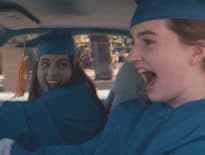
Cinema Fearité presents 'Village of the Damned'
Cinema Fearite takes a look at the gold standard of creepy kid movies, 'Village of the Damned.'
Creepy kids have always been a staple of the horror genre. Sometimes it’s a single kid, like in The Bad Seed or The Good Son. Sometimes, it’s just a handful, such as in The Children or Bloody Birthday. Still other times, there’s a whole tribe of killer kiddos, like in The Brood or Come Out and Play. The gold standard of creepy kids movies is 1960’s Village of the Damned.
Village of the Damned is about a small village in England called Midwich. One afternoon, all of the residents suddenly pass out, along with anyone who enters the village to check on them. A few hours later, the inhabitants wake up, seemingly unaffected by their bout with unconsciousness. Except for the fact that most of the adult women are now pregnant, even the ones who haven’t had sex.

Nine months later, the women give birth to happy, healthy children. As the kids grow up, they exhibit accelerated development, both physically and mentally. They also travel in packs, seemingly able to communicate telepathically with each other. The authorities know something is strange, but one of the parents, a professor named Gordon Zellaby (George Sanders from Rebecca and The Picture of Dorian Gray), convinces the government to let him study the children under the guise of teaching them. The more Gordon learns about the kids, the more he realizes that they are dangerous and must be destroyed.
Village of the Damned was directed by Wolf Rilla (Witness in the Dark) from a script that he and co-writers Stirling Silliphant (The Towering Inferno, The Swarm) and George Barclay (pen name of Ronald Kinnoch, who also wrote Devil Doll and The Secret Man) adapted from a novel called The Midwich Cuckoos by John Wyndham (who also wrote the novel upon which The Day of the Triffids was based). The story is quite ingenious, with an inventive – yet simple – concept that bucks the normal sci-fi trend of alien invasion movies.

At the center of the concept is, of course, the creepy kids. And the creepy kids in Village of the Damned have become the standard by which cinematic creepy kids have been judged ever since. Led by Gordon Zellaby’s son, David (played by popular British child actor Martin Stephens from The Witches and The Innocents), the children’s threat comes mainly from their ability to hypnotize people with a single look, forcing them to do self-destructive things like crash their cars or shoot themselves. They can also read the minds of the adults, so stopping them proves to be a formidable task.
Visually, the kids all share the same bright blond hair (an effect achieved with wigs on the young actors that also make their craniums look bigger), and their eyes glow ferociously when they activate their powers. The movie never actually answers the question of the exact origin of the children, but an extraterrestrial theory is hinted at (during their lessons, Gordon asks “Are you aware of life on another planet?” and gets vague replies). However, wherever the children come from, it’s enough to have the townspeople raising up torches and pitchforks by the end of the movie.

Wolf Rilla approached Village of the Damned with almost a documentary feel in mind, but cinematographer Geoffrey Faithfull (Phantom Ship) did get to put a creative stamp on the picture. The presentation is very matter-of-fact, with just a handful of double exposure tricks, such as the children’s glowing eyes, that are extremely effective each time that they are sparingly used (the eye gimmick was edited out of the British cut of the film for being “too scary”). Faithful also adds in some cool camera angles, both low and high shots, to help keep the kids front and center (and the influence can be seen in future creepy kid movies, most notably the aforementioned The Brood). Village of the Damned is creatively shot without ever bringing attention to the photography.

The versatile score for Village of the Damned was composed by Ron Goodwin (Frenzy, The Executioner). The music alternates between blaring horns and soft strings, melodic woodwinds and swirling harps. It’s equally suspenseful and melodramatic, evoking both the safety of classic film scores and the wonder of a sci-fi soundtrack. There are moments of calm and moments of uneasiness, sometimes within the same musical cue. Although it’s not as memorable or as revered as some of the other sci-fi or horror scores from the time, the music for Village of the Damned gets the job done, and gets it done right.
Village of the Damned would go on to spawn both a sequel in 1964 called Children of the Damned and a modern remake in 1995 by the legendary master of horror John Carpenter. But neither really holds a candle to the original. Sometimes, less is more, and the subtle simplicity of Village of the Damned wins out.

